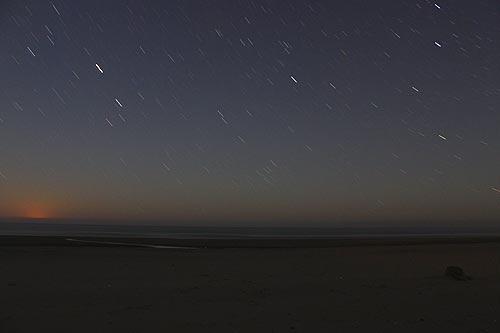Latest Astronomy Finds from Hubble: Early Stars, Beast Galaxy
Published 09/18/2015 at 9:24 PM PDT
By Oregon Coast Beach Connection staff

(Manzanita, Oregon) - From the Oregon Coast Science Section: A host of new discoveries from NASA's Spitzer and Hubble space telescopes is helping us to understand more about the early years after the Big Bang - and it has found a new "beast" of a galaxy.
Astronomers from California recently learned much more about the first five million years after the Big Bang, by coming up with the as-yet most accurate statistical estimate of the number of faint, small galaxies that existed then.
Previous studies included images of "intra-halo light" from stars distributed outside of galaxies. The latest data from Hubble discovered an infrared component in the background - essentially the collective glow of whole galaxies that were among the first formed in the universe.
These early galaxies were markedly different, said astronomers from the University of California at Irvine (UCI). They were not well-defined spiral and disk-shaped like those we know today. Instead, they were diffuse and populated by massive stars.
This period of five million years after the Big Bang is known as the "epoch of reionization." It was typified by a lot of darkness, say scientists, partially because of photon-absorbing neutral hydrogen. About this time, the universe began moving to a re-ordering of hydrogen gas due to the accelerated process of star and galaxy formation.
Also with the help of Hubble, astronomers have found a galaxy cluster with an incredible amount of new stars. Calling it a “rare beast,” scientists suggests that behemoth galaxies at the cores of these massive clusters can grow significantly by feeding off gas stolen from other galaxies.
"Usually, the stars at the centers of galaxy clusters are old and dead, essentially fossils," said Tracy Webb of McGill University, Montreal, Canada, lead author of a new paper on the findings published in the Aug. 20 issue of The Astrophysical Journal. "But we think the giant galaxy at the center of this cluster is furiously making new stars after merging with a smaller galaxy."
Most galaxy clusters have a one gigantic galaxy in the middle that doesn't produce new stars very rapidly. This behemoth churns out about 860 new ones a year. For reference, our resident Milky Way makes only about one to two stars per year.
More of these NASA images and starscapes from the Oregon coast below:



More About Oregon Coast hotels, lodging.....
More About Oregon Coast Restaurants, Dining.....
LATEST Related Oregon Coast Articles
Likely just before dawn best hour but peak happens during daylight. Weather
Dark Sky Week is Prime Along Oregon Coast: Where and Where Not to Go
General guide to dark sky viewing from south to north coast. Astronomy
Sizable Price Drop, Deals in Lincoln City During Quiet of April on Central Or...
20 perc off at A1 Vacation Rentals across its roster, including Gleneden Beach. Lincoln City specials
Upcoming S. Oregon Coast Events Include Gem Show, History: Coos Bay, Bandon
May 6 talk at Coos History Museum, Mayfly Fest May 17, Bandon Rock / Gem Show June 7,8
Washington Coast Cleanup on April 19 - Coinciding with Oregon Coast's SOLVE E...
From the Puget Sound to Long Beach, alongside Oregon's cleanup. Washington coast events, Seaside events
Astoria's Riverwalk Gets New Lighting, More N. Oregon Coast Roadwork
Delays coming this summer, but the riverwalk has a new look. Seaside, Cannn Beach
April Gets Even Cheaper Midweek at Depoe Bay, Lincoln City: Oregon Coast Deals
Off-season rates plus more at Keystone Vacation Rentals. Depoe Bay lodging specials, Lincoln City hotel reviews, Newport hotel reviews
Washington Coast Begins Week of Clam Digs, April 12 Through 18
Long Beach, Twin Harbors, Mocrocks and Copalis at different times. Washington coast events
Back to Oregon Coast
Contact Advertise on BeachConnection.net
All Content, unless otherwise attributed, copyright BeachConnection.net Unauthorized use or publication is not permitted















































